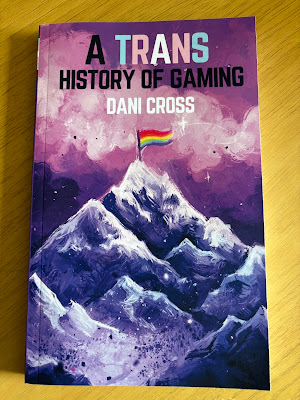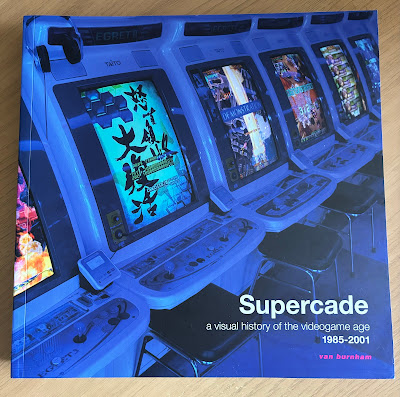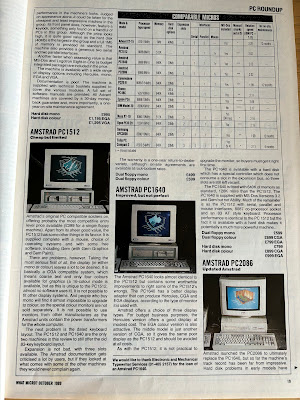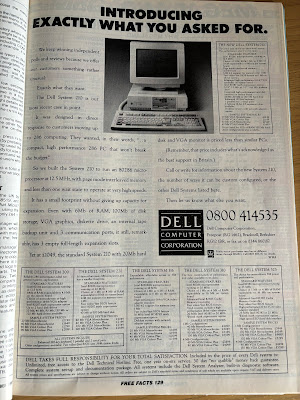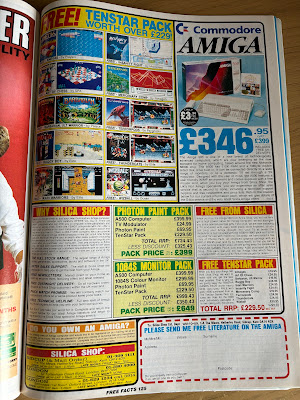Acorn User began its exceedingly long run in July 1982 and lasted all the way to issue 267 dated Christmas 2003. From the original Beeb to the A6 running Virtual Acorn (although Iynoix, Microdigital and RiscStation machines were still be advertised and, in some cases, actually sold as the final issue rolled off the press!), Acorn User appeared for many years to be the newsstand magazine for Acorn users. I know I picked up more than a few copies from WH Smiths back in the mid-90's. Today, we'll drop a bit further back, to a point where Acorn seemed to be doing pretty well, and check out what the summer of '92 had in store.

Got to say it takes a very "period" approach to the cover, and that top strip still has the BBC logo - that would disappear from issue 138, January '94. The full Acorn range is covered, and the venerable BBC Micro and Master (the latter hidden by the "Best Selling" corner label) remain in place next to the slightly spritelier Archimedes, the then three year old A3000 and 1991's A5000. And now to the news desk...
 |
| All together now: "Where in the world...?" |
The first item is about PC World, and we're talking about the very first store! A year later, they would become part of the Dixons Group, and thus spread like wildfire to high streets, shopping centres and retail parks across the land. But back in '92, it was just a single store, and one of Acorn's largest dealers, selling several thousand units per year! Ah, such innocent times...
 |
| Contents ahoy! |
Acorn take second place with news that they have weathered the recession, returning to profitability for the second half of 1991. A net profit of £694,000 in H2 offset the first half's £420,000 loss, although operating profit was down to £1.1million from £2.6 million. For the year, once interest payments and a "related" company write off of £102,000 had been dealt with, net profit was £274,000 compared to 1990's £1.58 million. Sales volumes dropped from £45.1 million to £40.9 million, but cost control and greater margins helped the previous overdraft of £6.5 million switch to a surplus of £1.4 million. Market share in Australia and New Zealand increased, and Olivetti maintained confidence in the UK firm.
If you take a quick look at how Acorn's competitors in the UK home computer market were fairing at the time, you can see that Acorn wasn't doing that bad considering the margins and market share of their more international foes. Atari posted a net profit in 1991 of $25.6m, which compares nicely with Commodore's $48.2m. Except neither result was anything to shout out about. Atari's figure included a realised profit of $40.9m from the sale of its Taiwanese manufacturing facilities - Archive.org has the 1991 financial report here. Commodore's profit came off the back of $1.04 billion in revenue. Neither of those situations should have inspired confidence at the time. Atari were loss making in general trading terms, and Commodore were haemorrhaging money uncontrollably so that even a relatively minor drop in sales would see profits wiped out. As it turned out, 1992 would see $911m in revenue and a profit of $27.6m. The following year, those figures were $590.8m and a loss of $356.5m (all Commodore figures from The Silicon Underground here). Whilst Acorn was never hugely or consistently profitable, they did enough, and had another string to their bow anyway...
Page 9 sees the news that Acorn has won its second Queen's Award for Technological Achievement for the ARM chip development (their first was for the BBC Micro). Present in over 180,000 Archimedes computers by that time, design had started eleven years earlier and was now handled by spin-of company Arm Ltd.
Speaking of Arm, a side bar notes the announcement of the Arm610, delivering 15 mips at 20 MHz. This was rather better than the Arm 3 in the A5000 and A540 (13.5 mips at 25MHz), and it wouldn't be long before the Arm610 found a home across the sea, as Arm co-owner Apple Computers would plonk one in their Newton PDA.
There a quick diversion to the usual Questions and Answers page, offering solutions to readers queries, before we get to the cover story... ARC vs MAC and PC!

A trio of specs battle it out. Acorn have their less than a year old A5000 pricing at £1,531 in its Learning Curve Pack guise. For that, you get a 25MHz Arm 3 chip (see above), 4Mb of RAM and a 40Mb hard drive. It suffers by lacking a maths co-processor, but still offers Super VGA (800x600) graphics modes and the sleek, minimalist footprint of RISC OS. Apple is represented by their Mac IIsi, with 5MB of RAM and 40Mb hard drive. There is disdainful commentary of the aging GUI and the slightly flaky System 7 OS, but the 68030 processor stands up reasonably well, and as noted, although the £2,500 asking price is much higher than the A5000, the more budget (ha!) conscious LCII models would have been closer in performance to the aging Archimedes A3000 and any generic 386SX. Finally, the PC rocks up with a 4Mb RAM/40Mb hard drive-equipped 486 running at 25MHz. At £1,365, this was about right for the time, but price benefit was set in contrast to the PC is held back by its legacy expansion bus and the wobbly mix of DOS and Windows. The key question was: which was best?
I mean, really? You have to ask in an Acorn mag?
Comparisons are made across Desktop Publishing, "Business" packages, Graphics, Printing and hardware expansion. "Typical users" will find everything they need on Acorn's machine, and whilst the Mac and PC had their place, viewing the A5000 on its merits means that it would be difficult to match the OS/hardware package anywhere else. Not surprising, but less partisan than expected. That didn't, however, really distract from the fact that the best general all-rounder then was the DOS/Windows PC.
 |
| Tell your kids this was The Matrix pre-1999. |
Moving on, there are features on getting the most from Impression (a DTP package that still proves useful to this day and a version of which was used to create Acorn User), Assembly Line programming help, the first in a new series on programming in C, the usual Yellow Pages of listings, and sections on Business, Graphics and Educational software.
 |
| Somewhere, beyond the C... |
Games are also covered, and by this stage of the Archimedes' life, there were quite a few leisure titles out there, belying the reputation RISC OS had garnered as just being suited to educational purposes. Aliped gets a decent review, Pesky Muskrats also just about passes muster, whilst Grievous Bodily 'Arm proves that side scrolling beat 'em ups are a thing for RISC OS players.
 |
| I see what they did with that fighting game title... |
It's adverts time now, and as this is a format specific mag, there are a lot of smaller companies to go alongside the more recognisable names (both within the RISC OS market as well as the wider computing scene).
 |
| ICS - a cornucopia of RISC OS kit. |
ICS lead off with two pages of software and hardware, covering pretty much all of your possible computing needs. You could argue that a sorting by type would have been useful but you can't deny that there was a good amount of software available.
 |
| When Watford closed down, they left a hell of a Gap in the market (not sorry at all!). |
Watford Electronics were another long time dealer of Acorn kit, and they take up thirteen pages! There is an absolute boatload of hardware, and it's cool to see the Cambridge Z88 still being advertised too. They were also a very familiar name in the PC world and would make a name for themselves selling reasonable DOS/Windows PC's for a few years.
Desktop Projects would sell you Acorns at rather reasonable prices - that basic A3000 with a 2Mb RAM upgrade for £599 ex VAT wasn't silly, and neither were the monitor packages either. That you could get an ST for less than £300 and an Amiga A1200 for under £400 was neither here no there, honest, guv'nor!
 |
| Some fine school memories unlocked with this advert. |
Clares had their impressive range of graphical packages for sale, and I remember using ProArtisan quite frequently back in comprehensive. Sadly, the school would never shell out for Render Bender II.
 |
| Dealers like these were once the lifeblood of the home computing market. |
There also quite a few smaller ads from dealers who would willingly flog you the Acorn set up of your dreams, and in true foot meets bullet style, Acorn would rearrange its dealer relations in the summer of 1995 and dismiss two thirds of its registered approved education dealers. A money decision to be sure, it also removed a good amount of local knowledge for potential buyers - but Acorn weren't the first to do that. In the US in 1987, Atari bought the Federated Group to provide dedicated retail space for the ST, as well as focussing on larger and more specialised resellers. As a result, the small dealer network abandoned the platform. Not saying if they hadn't, it would have changed things much, but it sure as hell didn't help!
 |
| A selection of superior Superior software? |
Finishing with games, and both The Fourth Dimension and Superior Software had been prolific with releases, and as you can see from both of their ads, they had games aplenty for players of all levels and interests.
 |
| 4D really were rather prolific back in the early 90's. |
That was Acorn User, a popular format specific publication that, while not as big as say Amiga or ST Format would be for their users, was more than good enough for the RISC OS and Beeb owning crowd. As for today's users, Archive magazine and Drag 'N' Drop still fly the flag for an OS that remains in active use and development. Check out RISC OS Open for updates on the current OS, and Riscository and The Icon Bar for news. The former has banners for the various RISC OS shows you can attend throughout the year, and here's a link to this year's Wakefield Show with a handy guide to most of movers and shakers in the RISC OS world.
